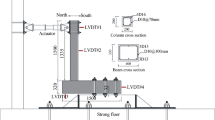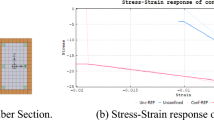Abstract
In a steel–concrete composite beam, the channel shear connector is an easy solution to ensure the connection due to its availability and the simplicity of its welding. However, increasing the channel shear connector length negatively affects the concrete slabs and creates difficulties to cross the longitudinal reinforcing bars. To solve this problem, five new channel shear connector shapes are proposed and studied in this paper. Twelve push-out tests using a new setup, and three pull-out tests, were carried out under monotonic loading to identify the shape that gives the best performance. The failure modes, the effects of new channel shapes on the load-slip behavior, the concrete slaps, the bending deformation, and the height between the two plastic hinges that appeared near the base of channel connectors were mainly studied. The study reveals that the modification of the channel shear connector shape is a promising way and positively influences the concrete-connector relationship and also the bending deformation capacity of the channel connector. As a result, the concrete cracking decreased, the ductility increased between about 15–31%, and the ultimate strength improved slightly between about 0–5.1%. Finally, the experimental results are compared to the existing equations.



















Similar content being viewed by others
References
ANSI-AISC, AS (2005) 360–05. Specification for structural steel buildings. Chicago: American In-stitute of Steel Construction.
Arıkoğlu, P., Baran, E., & Topkaya, C. (2020). Behavior of channel connectors in steel-concrete composite beams with precast slabs. Journal of Constructional Steel Research, 172, 106167.
Balasubramanian, R., & Rajaram, B. (2016). Study on behaviour of angle shear connector in steel-concrete composite structures. International Journal of Steel Structures, 16(3), 807–811.
Baran, E., & Topkaya, C. (2012). An experimental study on channel type shear connectors. Journal of Constructional Steel Research, 74, 108–117.
Baran, E., & Topkaya, C. (2014). Behavior of steel–concrete partially composite beams with channel type shear connectors. Journal of Constructional Steel Research, 97, 69–78.
CAN/CSA-S16-01 (2001). Limit states design of steel structures (Canadian Standard Association). Toronto, Ontario, Canada
Eurocode 2 (2005). Design of concrete structures - Part 1–1: General rules and rules for buildings. Brussels.
Eurocode 3 (2006). Design of steel structures - Part 1–8: Design of joints. BS EN 1993–1. Standard, British.
Eurocode 4 (2005) Design of composite steel and concrete structures - Part 1–1: General rules and rules for buildings. European Committee for Standardization.
Fanaie, N., Esfahani, F. G., & Soroushnia, S. (2015). Analytical study of composite beams with different arrangements of channel shear connectors. Steel Composite Structures, International Journal, 19(2), 485–501.
Kim, J.-S., Kwark, J., Joh, C., Yoo, S.-W., & Lee, K.-C. (2015). Headed stud shear connector for thin ultrahigh-performance concrete bridge deck. Journal of Constructional Steel Research, 108, 23–30.
Kwon, G., Engelhardt, M. D., & Klingner, R. E. (2012). Parametric studies and preliminary design recommendations on the use of postinstalled shear connectors for strengthening noncomposite steel bridges. Journal of Bridge Engineering, 17(2), 310–317.
Lam, D. (2007). Capacities of headed stud shear connectors in composite steel beams with precast hollowcore slabs. Journal of Constructional Steel Research, 63(9), 1160–1174.
Liu, Y., Zhang, Q., Bao, Y., & Bu, Y. (2019). Static and fatigue push-out tests of short headed shear studs embedded in Engineered Cementitious Composites (ECC). Engineering Structures, 182, 29–38.
Lowe, D., Das, R., & Clifton, C. (2014). Characterization of the splitting behavior of steel-concrete composite beams with shear stud connection. Procedia materials science, 3, 2174–2179.
Maleki, S., & Bagheri, S. (2008). Behavior of channel shear connectors, Part I: Experimental study. Journal of Constructional Steel Research, 64(12), 1333–1340.
Mazoz, A., Benanane, A., & Titoum, M. (2013). Push-out tests on a new shear connector of I-shape. International Journal of Steel Structures, 13(3), 519–528.
Naithani, K., Gupta, V., & Gadh, A. (1988). Behaviour of shear connectors under dynamic loads. Materials and Structures, 21(5), 359–363.
Oehlers, D., & Coughlan, C. (1986). The shear stiffness of stud shear connections in composite beams. Journal of Constructional Steel Research, 6(4), 273–284.
Oehlers, D. J., & Bradford, M. A. (1995). 14 - Embedment forces. In D. J. Oehlers & M. A. Bradford (Eds.), Composite steel and concrete structural members (pp. 336–349). Pergamon.
Pashan A (2006) Behaviour of channel shear connectors: push-out tests. University of Saskatchewan
Shariati, M., Ramli Sulong, N., Arabnejad, M., & Mahoutian, M. (2011). Shear resistance of channel shear connectors in plain, reinforced and lightweight concrete. Scientific research and essays, 6(4), 977–983.
Shariati, M., Shariati, A., Sulong, N. R., Suhatril, M., & Khanouki, M. A. (2014). Fatigue energy dissipation and failure analysis of angle shear connectors embedded in high strength concrete. Engineering Failure Analysis, 41, 124–134.
Shariati, M., Sulong, N. R., Shariati, A., & Kueh, A. (2016). Comparative performance of channel and angle shear connectors in high strength concrete composites: An experimental study. Construction and Building Materials, 120, 382–392.
Shariati, M., Tahmasbi, F., Mehrabi, P., Bahadori, A., & Toghroli, A. (2020). Monotonic behavior of C and L shaped angle shear connectors within steel-concrete composite beams: An experimental investigation. Steel and Composite Structures, 35(2), 237–247.
Shen, M., & Chung, K. (2017). Experimental investigation into stud shear connections under combined shear and tension forces. Journal of Constructional Steel Research, 133, 434–447.
Shim, C. S. (2004). Experiments on limit state design of large stud shear connectors. KSCE Journal of Civil Engineering, 8(3), 313–318.
Su, Q.-T., Yang, G.-T., & Li, C.-X. (2014). Structural behaviour of perforated shear connectors with flange heads in composite girders: an experimental approach. International Journal of Steel Structures, 14(1), 151–164.
Toghroli, A., Mohammadhassani, M., Suhatril, M., Shariati, M., & Ibrahim, Z. (2014). Prediction of shear capacity of channel shear connectors using the ANFIS model. Steel Compos Struct, 17(5), 623–639.
Topkaya, C., Yura, J. A., & Williamson, E. B. (2004). Composite shear stud strength at early concrete ages. Journal of Structural Engineering, 130(6), 952–960.
Tout F (2014) Experimental study of composite bonded structures : effect of creep, fatigue and durability. Université Claude Bernard - Lyon I
Viest IM, Siess CP, Appleton JH, & Newmark NM (1951) Full scale tests on channel shear connectors in composite T-Beams. University of Illinois Bulletin, pp. 405.
Zhao, Q., Du, Y., Peng, Y., Xu, C., & Huang, G. (2020). Shear Performance of Short Channel Connectors in a Steel-UHPC Composite Deck. International Journal of Steel Structures, 20(1), 300–310.
Zhu, Z.-H., Zhang, L., Bai, Y., Ding, F.-X., Liu, J., & Zhou, Z. (2016). Mechanical performance of shear studs and application in steel-concrete composite beams. Journal of Central South University, 23(10), 2676–2687.
Zona, A., & Ranzi, G. (2014). Shear connection slip demand in composite steel–concrete beams with solid slabs. Journal of Constructional Steel Research, 102, 266–281.
Acknowledgements
The authors would like to thank the Laboratory of Materials and Mechanics of Structures at the University of M’sila, Algeria.
Author information
Authors and Affiliations
Corresponding author
Additional information
Publisher's Note
Springer Nature remains neutral with regard to jurisdictional claims in published maps and institutional affiliations.
Rights and permissions
About this article
Cite this article
Maghaghi, B., Titoum, M. & Mazoz, A. Experimental evaluation of new channel shear connector shapes. Int J Steel Struct 21, 883–900 (2021). https://doi.org/10.1007/s13296-021-00478-x
Received:
Accepted:
Published:
Issue Date:
DOI: https://doi.org/10.1007/s13296-021-00478-x




